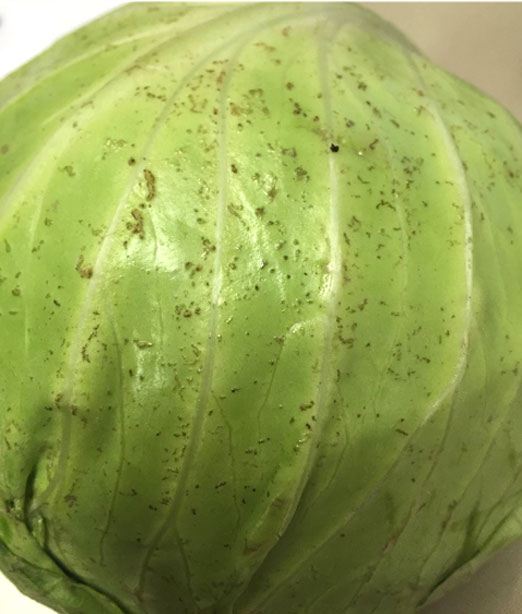In some cases, while cabbage is growing in the field, they sometimes come under assault from thrips. Specifically the onion thrip insect is the primary culprit. They will seek shelter underneath the cabbage leaves, and begin their feeding. As reported by the Ontario Ministry of Agriculture, thrips are small, slender and fast-moving. The adults are approximately 2 mm in length, pale yellow to brown in color and pointed at both ends. The male of the species is wingless and is rarely found. The females have four very slender wings fringed with close-set long hairs. When at rest, the wings are laid over the abdomen and extend slightly past it. The nymphs are similar in shape but smaller in size and pale yellow in color.
Feeding by thrips results in a proliferation of cells protruding from the injured epidermal layer of the head. The result is small, brownish-gray water-like growths on the leaf surface. The wrapper leaves may also show silver colored mottled lesions along with black fecal material. Feeding by thrips represents more of a cosmetic problem than a loss in yield.

The good news, if you do find this defect, the insects are most likely long gone, so this is treated as a quality defect, as the injury will not progress or become worse. But the USDA has not helped the industry with a solid scoring guideline. From the USDA’s Inspection Instructions for Cabbage, “On a 3 lb. head: score as damage when the aggregate area exceeds the equivalent area of a 2 inch circle on two head leaves.” Does this mean it has to be evident on at least 2 head leaves to be considered a defect? What if the aggregate area exceeds an area of a 6 inch circle, but on only one leaf, is this ignored? If you check the U.S. Grade Standard for Cabbage there is no specific scoring guideline for thrip injury, or any defect for that matter, only the standard, “score as a defect when materially affecting the appearance.”
So what should you do? If the USDA follows their own instructions literally an inspector may ignore this defect, unless it is found affecting an area greater than 2 inches on two head leaves. Fortunately most inspectors will use common sense and will score this head, as seen here, using the basic definition that the thrip injury is materially affecting the appearance.

One Comment on “Cabbage- Thrip Injury”
So, if I found thrip injury affecting an area of 5 inches on one leaf it would be ignored, but if I found thrip injury affecting 2 inches on one leaf, and 1/8 inch on another it would be a defect? Does anyone at the USDA read what they write? Do they actually apply their scoring guidelines in a real setting, or do they just sit at a desk and think up stupid things?